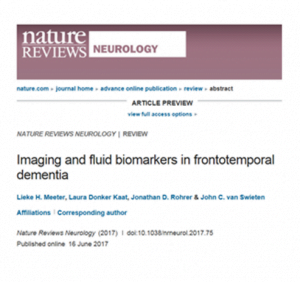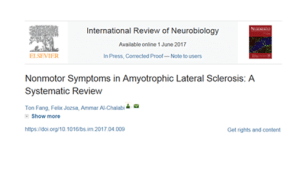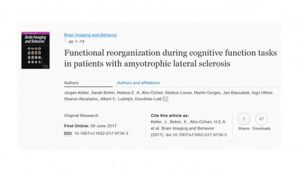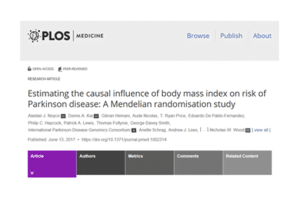 „Imaging and fluid biomarkers in frontotemporal dementia“ has been published in the journal Nature Reviews Neurology. This work was supported in part by JPND through the PreFrontALS project, selected in the 2013 Preventive Strategies call.
„Imaging and fluid biomarkers in frontotemporal dementia“ has been published in the journal Nature Reviews Neurology. This work was supported in part by JPND through the PreFrontALS project, selected in the 2013 Preventive Strategies call.
Yearly Archives: 2017
Complex neurotechnological devices are required to directly select and influence brain waves inside the skull’s interior. Although it has become relatively easy to implement the devices, researchers are still faced with challenges when trying to keep them running properly in living organisms over time. But that could be changing now, thanks to a new method.
A research team was able to create a microprobe that grows into neural tissue without inflammation and with the help of a medicinal coating. Even after twelve weeks it was shown to still be able to deliver strong signals. Now that such implants are no longer required to be replaced as often, they are able to open the doors for better diagnoses while making life easier for the chronically ill — such as Parkinson’s patients that need to be treated with brain stimulation methods.
The study was published in the journal Biomaterials.
The research group showed that flexible microprobes made of so-called polyimides offer distinct advantages over implants made of silicon. By using a special coating on the electrodes placed on the polyimide implant, the researchers, using an animal model, also showed that inflammatory reactions can be delayed longer.
The electrodes‘ coating is made from the polymer PEDOT that absorbs medicine and, when applying negative voltage, releases it again — in this case, the anti-inflammatory compound dexamethasone. Compared to traditional methods for drug administering, a much lower dosage can be used. It also makes it possible to limit the effects to a specific area. In that way, undesirable side effects from the medicine can be reduced.
The researchers say that many more promising avenues for long-term treatments with, for instance, deep brain stimulation can be explored with this system.
Paper: “Actively controlled release of Dexamethasone from neural microelectrodes in a chronic in vivo study”
Reprinted from materials provided by Albert-Ludwigs-Universität Freiburg.
 „Nonmotor Symptoms in Amyotrophic Lateral Sclerosis: A Systematic Review“ has been published in the journal International Review of Neurobiology. This work was supported in part by JPND through the ALS-CarE project, selected in the 2012 Healthcare Evaluation call.
„Nonmotor Symptoms in Amyotrophic Lateral Sclerosis: A Systematic Review“ has been published in the journal International Review of Neurobiology. This work was supported in part by JPND through the ALS-CarE project, selected in the 2012 Healthcare Evaluation call.
Stimulating the brain by taking on leadership roles at work or staying on in education helps people stay mentally healthy in later life, according to new research.
The large-scale investigation, published in the journal PLOS Medicine, used data from more than 2,000 mentally fit people over the age of 65. It examined the theory that experiences in early or mid-life which challenge the brain make people more resilient to changes resulting from age or illness – they have higher “cognitive reserve”.
The analysis found that people with higher levels of reserve are more likely to stay mentally fit for longer, making the brain more resilient to illnesses such as dementia.
The research team analysed whether a healthy lifestyle was associated with better performance on a mental ability test. They found that a healthy diet, more physical activity, more social and mentally stimulating activity and moderate alcohol consumption all seemed to boost cognitive performance.
Paper: “Potentially modifiable lifestyle factors, cognitive reserve, and cognitive function in later life: A cross-sectional study”
Reprinted from materials provided by University of Exeter.
 „Functional reorganization during cognitive function tasks in patients with amyotrophic lateral sclerosis“ has been published in the journal Brain Imaging and Behaviour. This work was supported in part by JPND through the NEEDS in ALS project, selected in the 2012 Healthcare Evaluation call.
„Functional reorganization during cognitive function tasks in patients with amyotrophic lateral sclerosis“ has been published in the journal Brain Imaging and Behaviour. This work was supported in part by JPND through the NEEDS in ALS project, selected in the 2012 Healthcare Evaluation call.
Among adults who entered a study more than 25 years ago, an increasing number of midlife vascular risk factors, such as obesity, high blood pressure, diabetes, high cholesterol and smoking, were associated with elevated levels of brain amyloid later in life, according to a study published by JAMA.
Midlife vascular risk factors have been associated with late-life dementia. Whether these risk factors directly contribute to brain amyloid deposition is less well understood. A team of researchers examined data from 346 participants without dementia at study entry who have been evaluated for vascular risk factors and markers since 1987-1989 and with PET scans in 2011-2013 as part of the Atherosclerosis Risk in Communities (ARIC)-PET Amyloid Imaging Study. Positron emission tomography image analysis was completed in 2015. Vascular risk factors at ARIC study entry (age 45-64 years; risk factors included body mass index 30 or greater, current smoking, hypertension, diabetes, and total cholesterol 200 mg/dL or greater) were evaluated in models that included age, sex, race, APOE genotype, and educational level.
The availability of imaging biomarkers for brain amyloid allows the study of individuals before the development of dementia and thereby allows consideration of the relative contributions of vascular disease and amyloid to cognition, as well as the contribution of vascular disease to amyloid deposition.
The researchers found that a cumulative number of midlife vascular risk factors were associated with elevated brain amyloid. Relationships between vascular risk factors and brain amyloid did not diffe&r by race. The results were not supportive of a significant difference in association among people who were or were not carriers of an APOE ε4 allele (a variant of a gene associated with increased risk for Alzheimer disease). Late-life vascular risk factors were not associated with late-life brain amyloid deposition.
Paper: “Association Between Midlife Vascular Risk Factors and Estimated Brain Amyloid Deposition”
Reprinted from materials provided by The JAMA Network Journals.
 „Estimating the causal influence of body mass index on risk of Parkinson disease: A Mendelian randomisation study“ has been published in the journal PLOS Medicine. This work was supported in part by JPND through the COURAGE-PD project, selected in the 2012 Risk Factors call.
„Estimating the causal influence of body mass index on risk of Parkinson disease: A Mendelian randomisation study“ has been published in the journal PLOS Medicine. This work was supported in part by JPND through the COURAGE-PD project, selected in the 2012 Risk Factors call.
In a new study published in The Journal of Biological Chemistry, researchers report advances in the understanding of how the protein TDP-43 causes damaging plaques to build up in neurodegenerative illnesses like amyotrophic lateral sclerosis (ALS) and a form of dementia called frontotemporal lobar degeneration. TDP-43 is an important protein tied to cell survival, metabolism and function that has been conserved by evolution in animals from flies to humans. Without TDP-43, scientists see animals develop locomotive defects and shortened lifespans. Mice that lack this protein do not survive beyond the embryonic stage. It regulates many genes and controls the processing of messenger RNA.
When TDP-43 builds up in cells, however, it causes damaging plaque to accumulate; this is a hallmark of ALS and frontotemporal lobar degeneration. It also is present in other types of neurodegenerative diseases, including Alzheimer’s disease.
In addition to ALS, TDP-43 is found in cases of frontotemporal dementia, a type of dementia that is distinct from Alzheimer’s disease. Where Alzheimer’s patients develop memory problems, those with frontotemporal dementia lose inhibition and undergo a gradual decline in behavioral and speaking ability.
TDP-43 is also tied to other neurodegenerative disorders and was recently shown to be present in many Alzheimer’s disease patients as well. While the connection to Alzheimer’s is not yet understood, scientists speculate that TDP-43 may be a secondary pathology or a marker of Alzheimer’s disease.
Among all of these neurodegenerative disorders is a common factor: they are characterized by the irreversible accumulation of plaques. A protein or set of proteins aggregates, causing plaque to build up. And scientists know that in ALS and frontotemporal dementia, the aggregating protein is TDP-43.
The researchers aimed to learn more about how TDP-43 works within cells and is regulated. Their first question was a matter of balance. TDP-43 is an indispensable protein that needs to accumulate in order for vital cell processes to occur. Too much, though, and the protein aggregation causes plaques to build up.
The team decided to see if phosphorylation — one of the most common ways that proteins are regulated — may be responsible for managing the activity, location and how tightly the protein binds. Scientists know that when they stress cells in a certain way, they activate a heat shock response, triggering phosphorylation. The researchers used this procedure to see if phosphorylation was involved with TDP-43’s actions, and found that the kinase MEK phosphorylates at two residues.
Next, the researchers wanted to know if phosphorylation was affecting protein functions, and they found that it regulates the ability to control processing, causing TDP-43 to go to an area where it wasn’t previously.
Paper: “Heat Shock-induced Phosphorylation of TAR DNA-binding Protein 43 (TDP-43) by MAPK/ERK Kinase Regulates TDP-43 Function”
Reprinted from materials provided by Saint Louis University.
 „The small heat shock protein B8 (HSPB8) efficiently removes aggregating species of dipeptides produced in C9ORF72-related neurodegenerative diseases“ has been published in the journal Cell Stress & Chaperones. This work was supported in part by JPND through the CureALS project, selected in the 2015 JPco-fuND call.
„The small heat shock protein B8 (HSPB8) efficiently removes aggregating species of dipeptides produced in C9ORF72-related neurodegenerative diseases“ has been published in the journal Cell Stress & Chaperones. This work was supported in part by JPND through the CureALS project, selected in the 2015 JPco-fuND call.
Psychiatric disorders do not increase the risk of Alzheimer’s disease, a new study shows. However, the prevalence of psychiatric diagnoses increased before the Alzheimer’s diagnosis, which might be due to prodromal symptoms of Alzheimer’s disease. The results were published in European Psychiatry.
History of mood disorder, such as depression, or any psychiatric disorder were associated with a higher risk of Alzheimer’s disease when psychiatric disorders that occurred at least five years before the Alzheimer’s diagnosis were taken into account. However, the associations disappeared when this time window was extended to 10 years. The exponential increase in the prevalence of psychiatric disorders before the diagnosis implies that some of these psychiatric disorders might actually have been prodromal symptoms of Alzheimer’s disease. This underlines the importance of proper differential diagnostics of Alzheimer’s disease. Further, the findings also highlight the importance of using an appropriate time window when assessing the risk factors of neurodegenerative diseases with a long onset period. Otherwise the identified „risk factors“ may actually be manifestations of the neurodegenerative disease.
Although psychiatric disorders diagnosed 10-40 years before Alzheimer’s disease were not related to a higher risk, the life expectancy of persons with psychiatric disorders was, and is still decreased. Thus, those persons with psychiatric disorders who lived long enough to develop Alzheimer’s disease were a selected sample of all persons with psychiatric disorders.
Paper: “Hospital-treated mental and behavioral disorders and risk of Alzheimer’s disease: A nationwide nested case-control study”
Reprinted from materials provided by the University of Eastern Finland.
